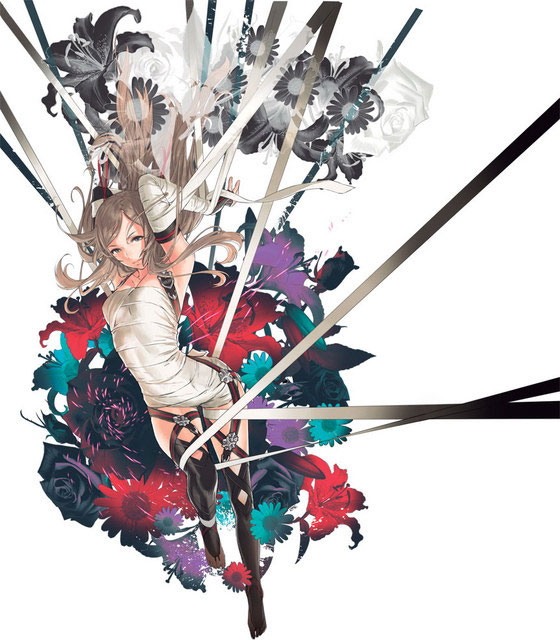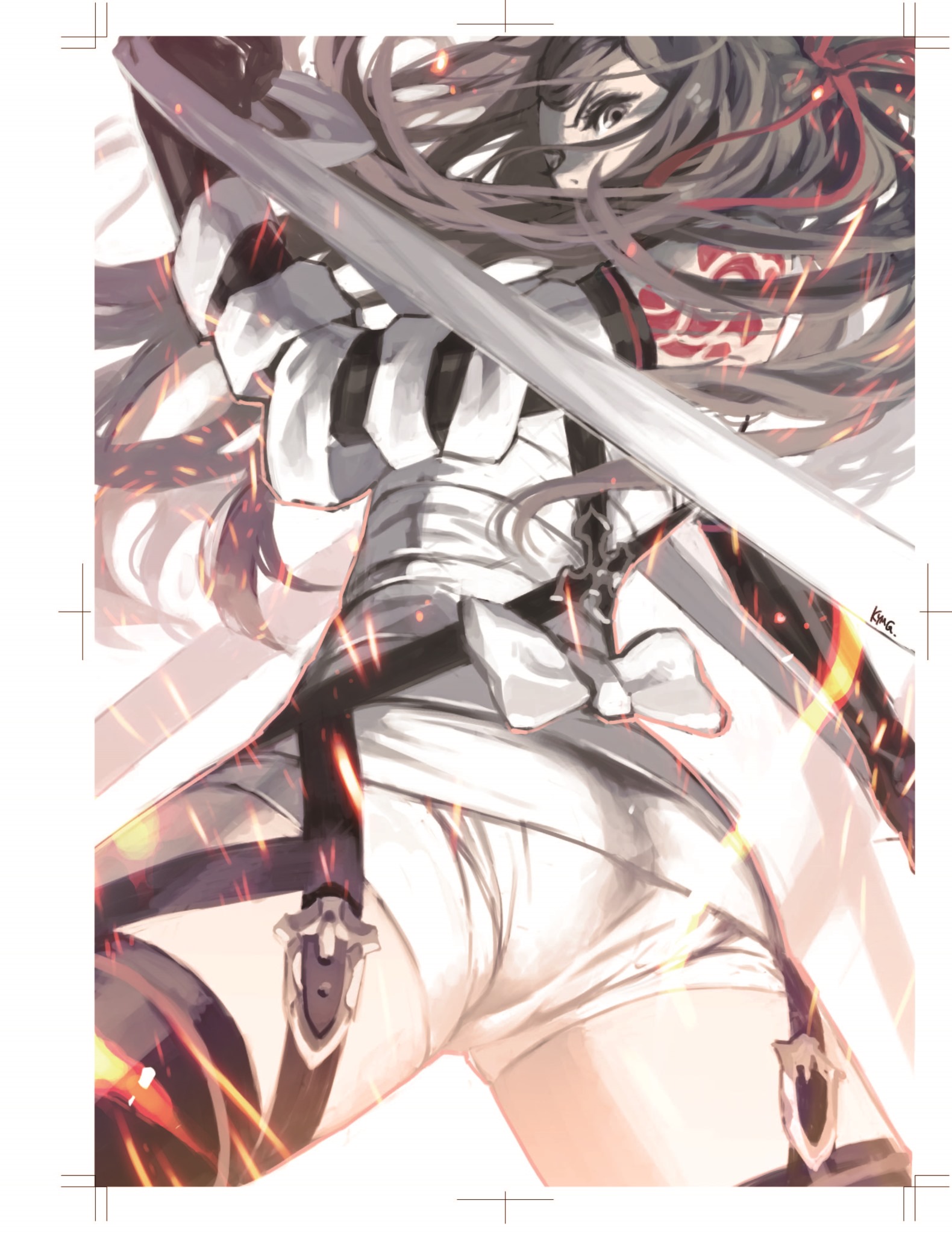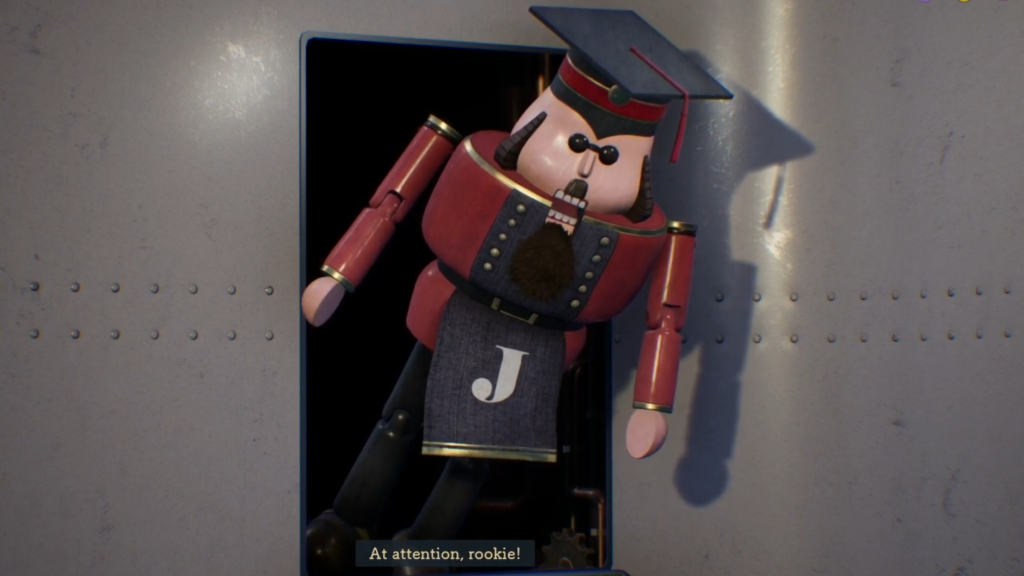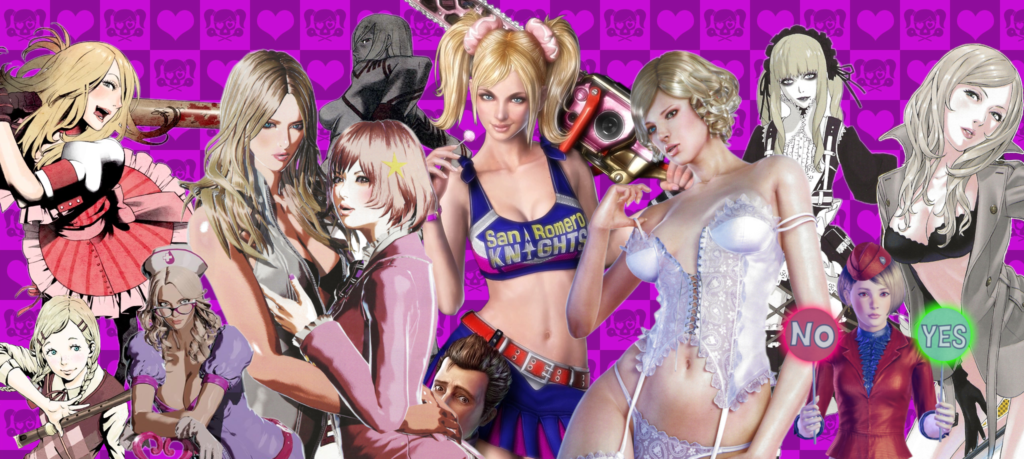
January of 2013 saw the announcement of Grasshopper Manufacture’s acquisition by GungHo Online Entertainment.

GungHo was the brainchild of Taizo Son, a Japanese businessman of Korean ancestry, who originally founded the company in 1998 as “Onsale” before changing its name to “GungHo” in 2006. Their success was mostly built upon the popular MMORPG Ragnarok Online, which was developed by their Korean subsidiary Gravity and for which they hosted the Japanese servers.
In 2012, GungHo released the mobile puzzle game Puzzle & Dragons: an outstanding success, by 2013 it produced 91% of the company’s revenue.
It would be easy to infer that GungHo decision to purchase Grasshopper was informed by the experience they accumulated working on mobile titles through their 2012 project Grasshopper Universe. However, surprisingly, the mobile division of GhM ended up splitting in a separate company called Planet G, meaning that GungHo only acquired the personnel experienced in developing console games.
It should be noted that, while most of their catalog was comprised of online and mobile games, GungHo had already tried to break into the console market before, both as publishers and as developers, mostly through single-player spin-offs of their successful Ragnarok franchise.
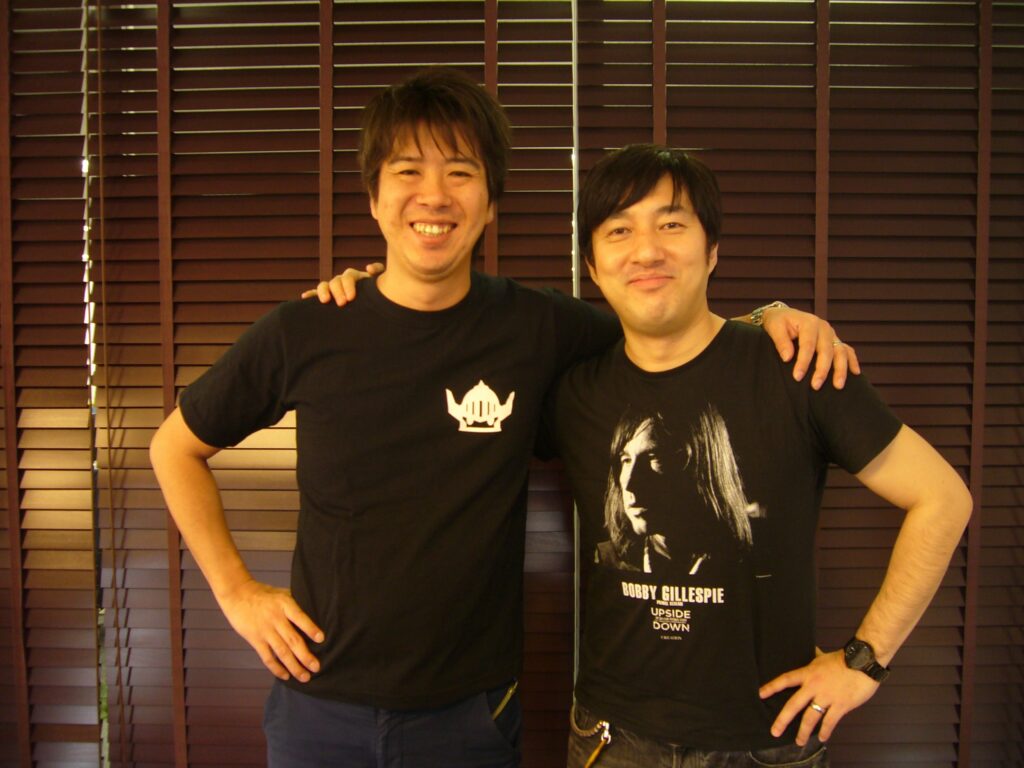
In a Famitsu interview, Suda revealed that the acquisition proposal actually came from his side: he became acquainted with Kazuki Morishita, GungHo’s CEO, during the summer of 2012, and ultimately decided to ask him to work together. Suda saw the acquisition as a means to expand Grasshopper’s possibilities in the world of online gaming, as their catalog, outside of their short foray in the mobile world, was largely comprised of single-player console games.
Morishita was initially reluctant to go through with the acquisition, as he saw Grasshopper as an independent studio who would not fit organically in a corporate environment; however, after he and Suda began discussing future potential projects, the two hit it off, and Morishita decided to have the financial department go through with the buyout.
Through the course of 2013, Grasshopper released several projects which were already in production before the acquisition; their first actual project under GungHo was announced in March 2013 as Lily Bergamo.
QUOTE OF ENLIGHTENMENT:

仕様をガチガチ決めるという感覚はあんまりないんですけど、基本的にゲームのコンセプトが後々ぶれるとプロジェクトが崩壊しやすいというのが経験としてあるので、ゲームデザインとしての重要なコンセプトは最初にきっちり考えておきましょう、ビジュアルイメージを頭のなかではっきり明確化させておきましょう、という部分はありますね。多少ブレそうになってもそこがしっかりしていれば対応できるので。でも、割と企画会議では好き放題言ってます(笑)。
– Kazuki Morishita
FUN FACT: Lily Bergamo never came out.
From its announcement, Lily Bergamo seemed to be a direct continuation of the hack-and-slash style GhM had been developing since No More Heroes 2; described as an “extreme action game” built in Unreal Engine for PlayStation 4, it would star heroine Tae Ioroi fighting some unspecified monstrous threat in the future of 2043.
Nobutaka Ichiki was set to direct, returning to the chair after No More Heroes 2, with Yosuke Kozaki also returning as an artist. That’s not the last connection its initial announcement teased with the universe of No More Heroes: one piece of concept art showed a character remarkably similar to Shinobu Jacobs, implying that she might make an appearance in the finished game.
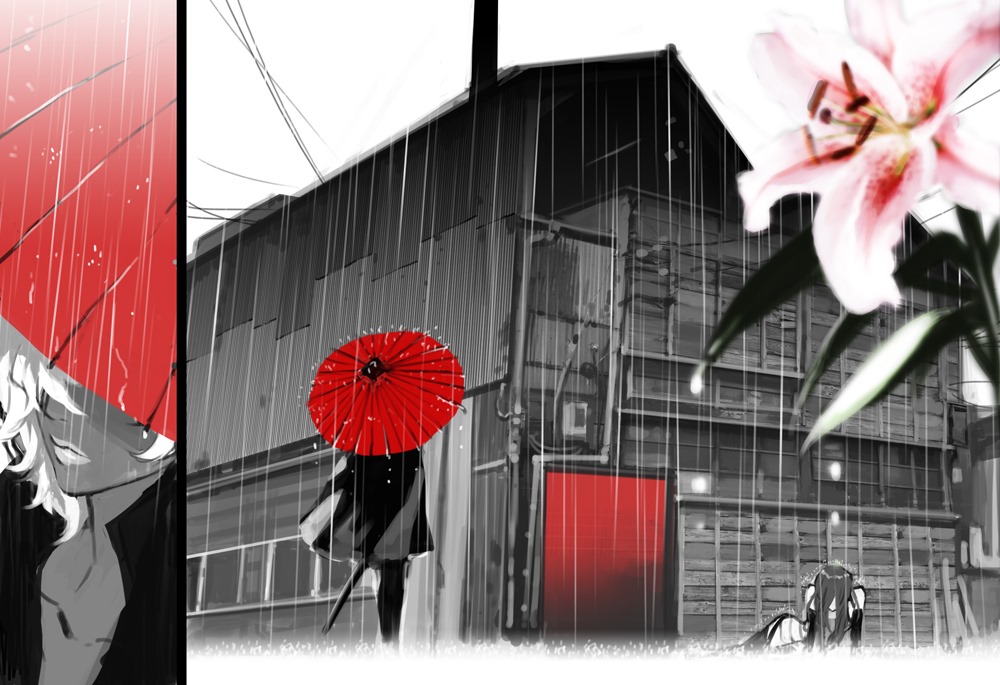
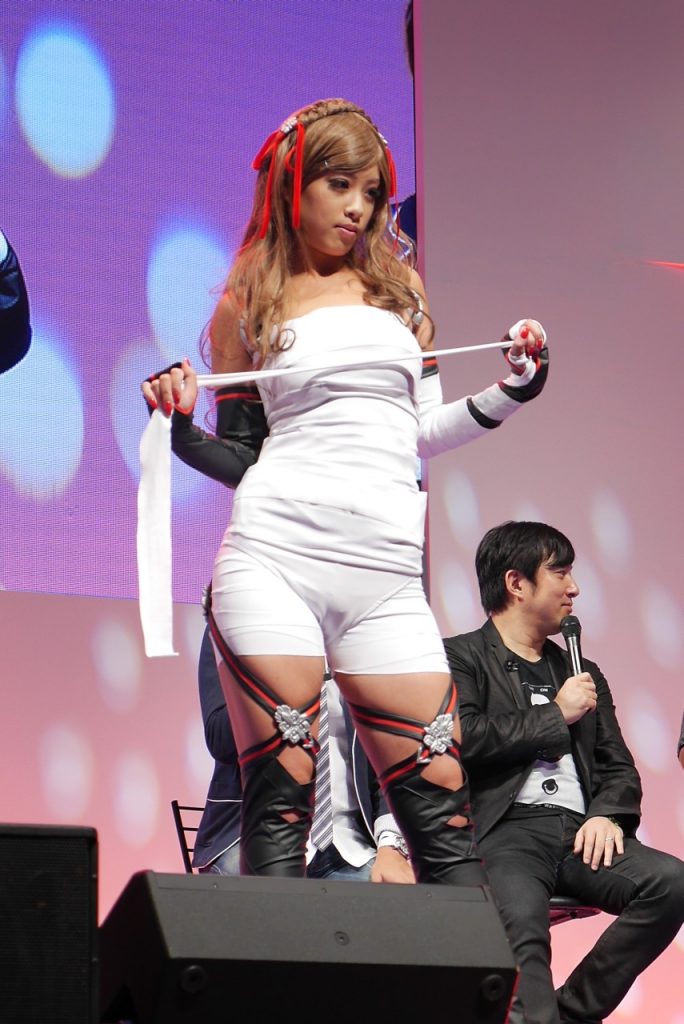
The most ambitious aspect of the game was an asynchronous multiplayer component, possibly inspired by the breakaway success of Dark Souls, which was also set to interact with a dedicated smartphone app. Unfortunately, since the game was never released, the app’s functionalities remain unknown.
A trailer for Lily Bergamo was released in September of that same year during Tokyo Game Show. A press event was also held, where Suda, Ichiki, Kozaki and Morishita discussed the game while a cosplayer, dressed up as Tae Ioroi, proudly showed off her cameltoe on stage.
The game was set to be released in 2014; however, the TGS press event would be the last time anyone heard of Lily Bergamo.
Even when visiting Rome’s video game museum, Vigamus, to receive a career award, Suda evaded all questions regarding Lily Bergamo. This fact was only brought up to point out that Suda met the owner of this website in that occasion.
The 2014 E3 conference, taking place in June, saw the surprise announcement of the next Grasshopper game, Let it Die. The ultra-violent, scrapyard aesthetic of Let it Die was a far cry from the cleaner and more gynocentric anime style of Lily Bergamo, and yet, later interviews clarified that Let it Die was, in fact, built upon the foundation laid by Tae Ioroi’s corpse.
As it turns out, development shifted drastically around the end of 2013: the team decided to place their focus on the game’s asynchronous online elements while scrapping Lily Bergamo’s storyline and art direction, as well as the proposed companion app.
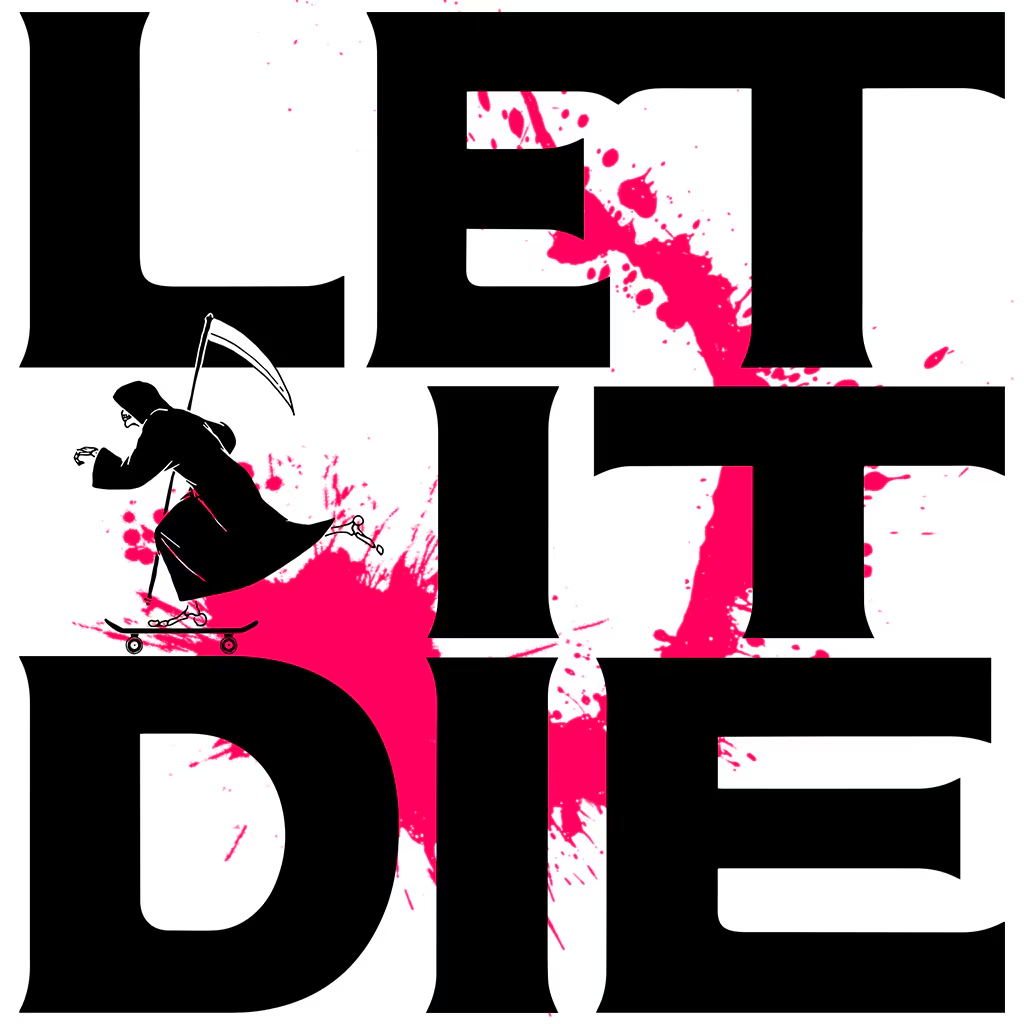
The core idea behind Let it Die would be that, as various players advanced through the game, when dying their data would be registered in a shared server, and their corpses would come back to life as enemy mobs for other players to fight. The art direction and story were scrapped in order to accomodate this change in direction.
The game was originally scheduled to be released in 2015, but it ended up being delayed to December 2016, meaning that a full four years passed between the buyout and the first actual Grasshopper/GungHo release. Ichiki was demoted to the role of designer, while directorial duties instead fell on Hideyuki Shin, who had previously directed Killer is Dead.
Also returning from KiD’s development team are Takashi Kahara as art director, Tadayuki Nomaru as concept artist and Yudai “You Die” Yamaguchi as cinematic director. SUDA51 is credited as Executive Director, and though he did not serve as main writer, he still created the general outline and scenario alongside supervisor Dai Sato, and Let it Die still ended up featuring some of his specific eccentricities. The actual script was instead written by Muga Takeda and SEKISHIRO, both presumably employees of Storyriders Co., Ltd., a Japanese company credited with general script supervision.
Akira Yamaoka again served as sound director, and outside of composing a few ambient tracks, his work mostly consisted of hand-picking over 100 Japanese bands to compose original songs for the game, having each of them operate independently with the only condition being that they would name the song “Let it Die”. In an inexplicable design choice, this veritable cornucopia of music was initially only available to listen to in the tower’s home base, before a patch made the songs available through regular gameplay.
The post-apocalyptic world of Let it Die was shook by a massive earthquake, the Earth Rage, in the year 2026, which left the world in ruins. South-western Tokyo split off from the mainland, becoming an island, and a mysterious tower gradually sprung out of its ruins: the Tower of Barbs, clearly a parody of the Tower of Babel.
Legend has it that the Tower of Barbs hides untold riches and treasures, and so, many adventurers tried to brave it, but none of them returned to tell the tale.
The actual story of the game begins at an unknown point at least 20 years after these events; the player character, whose actual appearance is never shown, hangs out at the Hated Arcade, alongside Mejin (voiced by game developer Toshiyuki Takahashi), a master gamer who can provide tips, Naomi Detox (voiced by singer Madoka), a ko-gal clerk who handles sidequests, and Uncle Death, a skateboarding skeleton and owner of the establishment.
It is Uncle Death who introduces the player character to Let it Die, a videogame which is played through the Death Drive 128, a game console, produced by Yotsuyama Electronics, that allows players to control repurposed corpses in order to explore the Tower of Barbs without any risk to their actual bodily flesh.
IL MANIFESTO
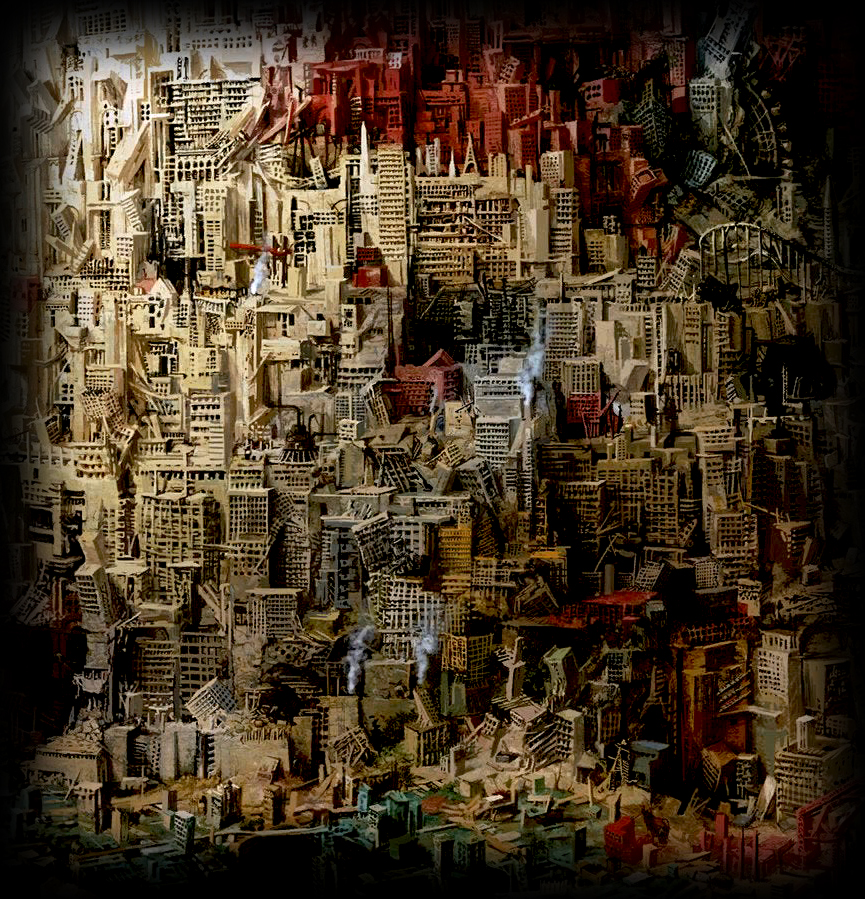
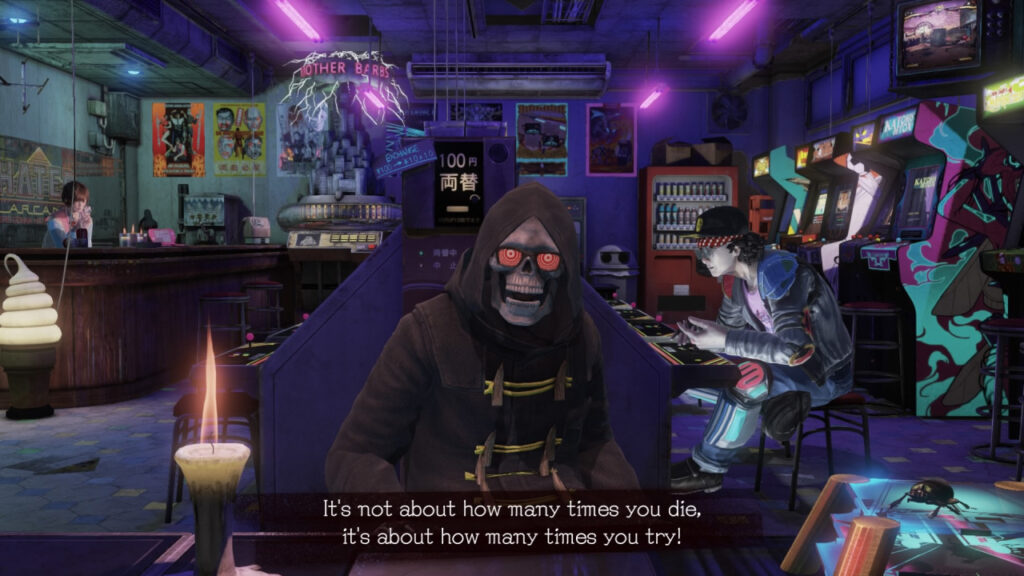
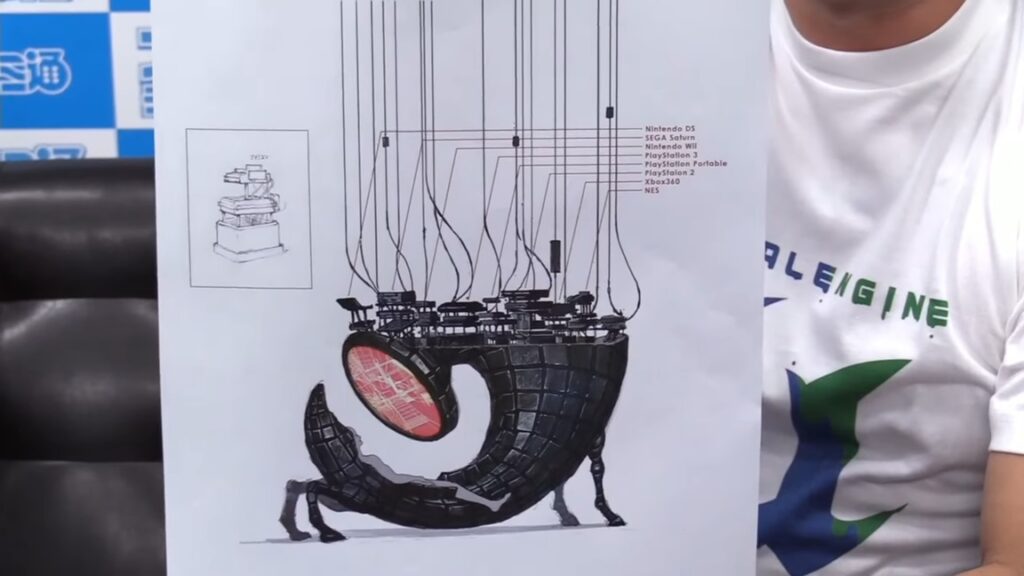
The Death Drive console will be surprisingly relevant to Suda’s later work, and it was not originally conceptualized for this game: in a Famitsu interview, which was translated by Nintendoeverything, Suda revealed that he was once contacted by New York’s Museum of Modern Art to design a game that would serve as an installation. He responded by sending them concept art for the Death Drive console, which he considered to be the future of gaming, a console that would allow players to “dive” into the game.
This utterly befuddled his MoMA correspondent, which reiterated their request for an interactive game that could be displayed in the museum. When Suda replied that he could develop a game for the Death Drive for them, communications ceased.
The basement of the Tower of Barbs serves as the game’s main hub, and it comes with its own colorful cast of characters: pole-dancing whore Momoko Yamada (voiced by singer Marianne Shinonome), also known as the Mushroom Magistrate, teaches the player about the Mushrooms that can be found within in the tower, as well as handling the game’s gacha system. Kommodore Suzuki is the owner of the Chokufunsha shop, and handles the player’s equipment and items, while his divorced twin brother, Kommando Kawasaki, runs the wandering shop Gyakufunsha with his toddler offspring in order to pay for his alimony. Tetsuo is a living doll that allows your character to raid other players’ bases through the Tokyo Death Metro system.
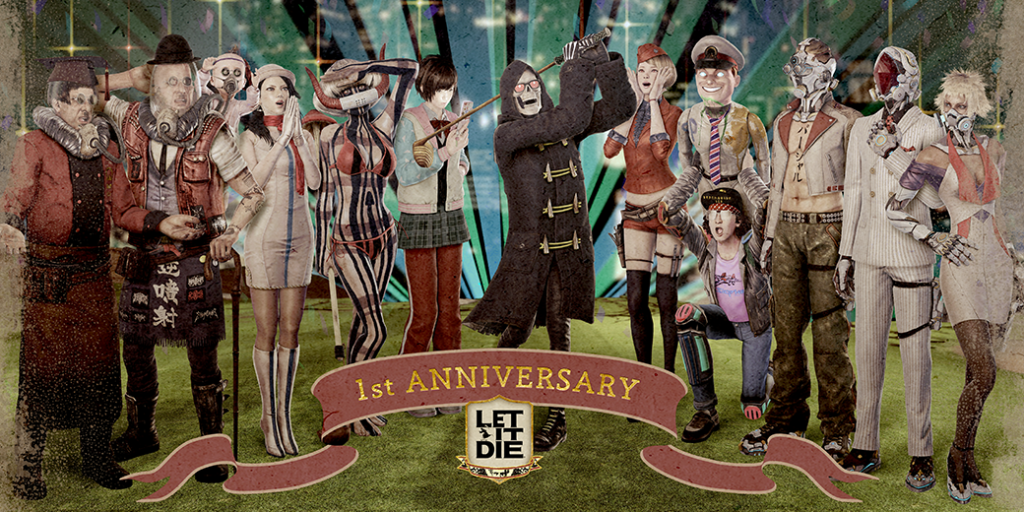
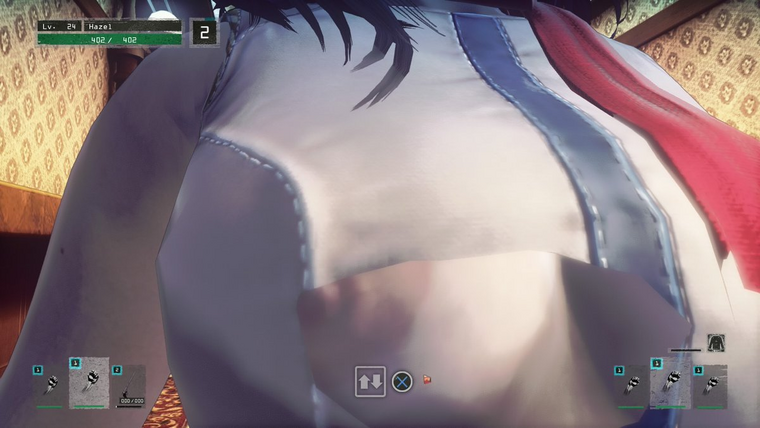
The game’s mandatory blonde is Kiwako Seto, an insurance agent who will greet players when they die and also show up after boss fights to take celebratory pictures.
Rin Torai handles the premium elevator, a shortcut to the tower’s higher floors, and is mostly notable for having fully modeled nipples and panties, normally invisible through regular gameplay.
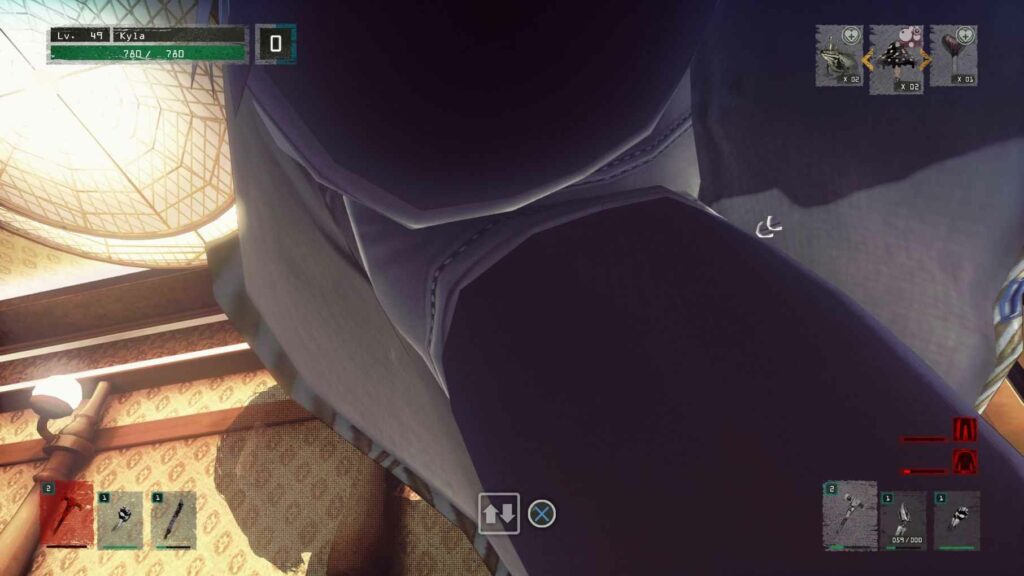
When the game originally came out, the tower was 41 floors high, and control of it was split between four different factions, each led by a sentient decapitated head, the four Dons.
The backstory of each of them can be read in collectible comicbook pages, while their entrances are depicted as puppet shows, in a surprising example of GhM’s earlier mixed media style.

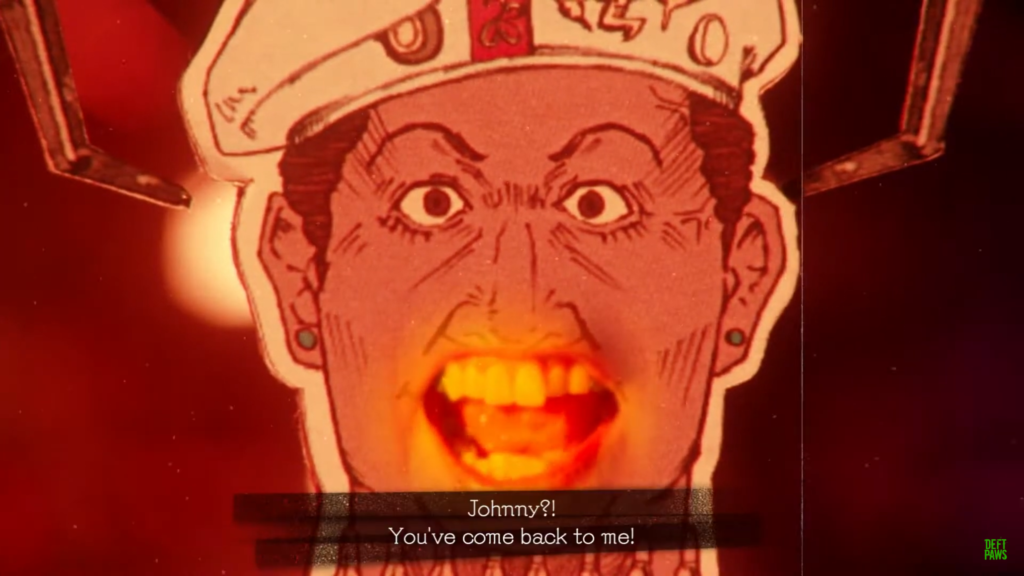

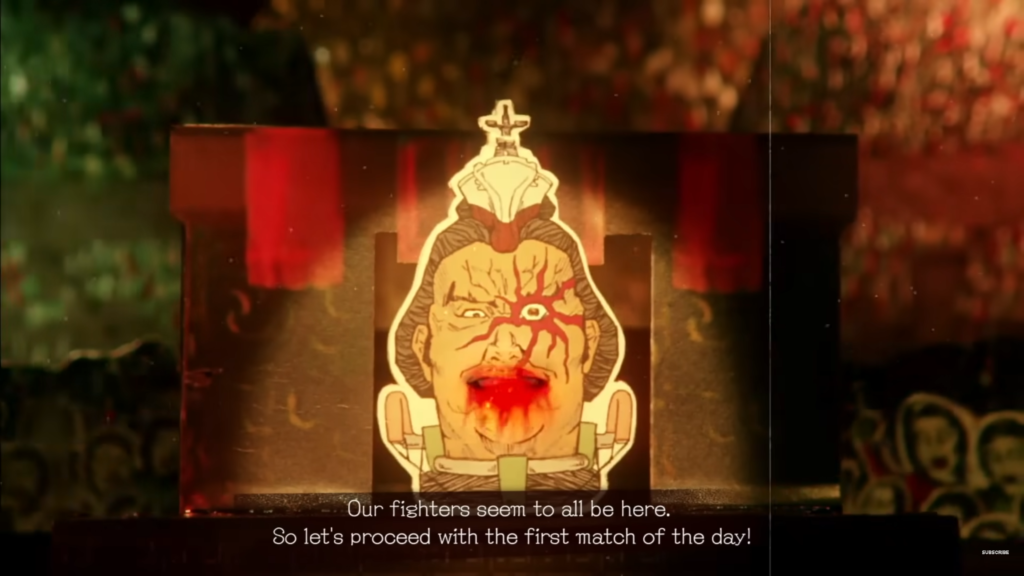
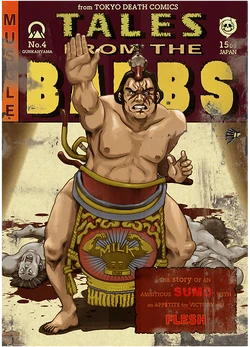
Each of the tower’s segments sports a different aesthetic, both in terms of level design and in terms of enemy equipment, depending on the local Don’s eccentricities: the troops of Max Sharp, a DIY maniac, inhabit a sewer area and sport garments that would normally be worn by mechanics or technicians, with power tools serving as weapons.
Meanwhile, Colonel Jackson is an ex-soldier, and therefore his army, stationed in a section of the tower resembling an abandoned city, wears military garb and utilizes firearms. Mr. Crowley was a D&D aficionado, and so his followers use equipment that would normally be found in fantasy RPGs, such as magic wands and medieval swords, inhabiting an area that strongly resembles an abandoned theme park. Lastly, M.I.L.K. is led by Taro Gunkanyama, an ex-wrestler, and therefore his team, lurking on the rooftops of what used to be Tokyo, utilizes sportswear and repurposed sports equipment.
The gameplay loop revolves around exploring the randomized floors of the Tower of Barbs through the aforementioned corpses; the way up is, however, hardly a straight line: players will have to move sideways, diagonally and unlock pathways left and right in order to make meaningful progress, with elevators marking legitimate checkpoints that players can use to return to their home base and back to the specific floor at any point.

Moreover, the tower will shift and turn depending on the day of the week, with a total of five different rotations which change the order in which certain floors are accessed as well as unlocking exclusive areas.
Each of the four faction areas only has a handful of rooms designed for it; however, every time the player enters the tower, the layout of each floor is randomized by combining said rooms in different ways, meaning that memorizing a floor’s layout is impossible.
The game itself is a hack-and-slash, which might seem expected from Grasshopper at this point, but while it does contain some of the DNA of their previous projects, mostly in the fact that it combines close-quarters and long-range combat, the execution is markedly different from the fast-paced antics of No More Heroes or Killer is Dead; possibly in an attempt to imitate the Souls series, the player is committed to each attack until the end of its animation, making gameplay much slower and methodical.
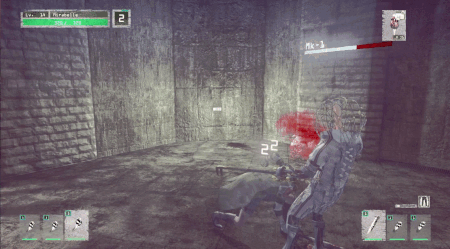
Moreover, the game sees the implementation of more RPG systems than any past Blonde Era title: while all of Grasshopper’s action game featured some sort of enhancement system for the player character, progression in Let it Die is very much gated by the quality of the character being controlled and their equipment, meaning even extremely skilled players would not be able to complete the game relying on reflexes alone.
Let it Die is described by Uncle Death himself as a “Rogue-like”. The term has suffered more abuse than a young girl on Epstein Island at this point, rendering it essentially meaningless, but generally speaking it refers to the 1980 game Rogue, a procedurally generated dungeon crawler in which the player character did not have the ability to be resurrected nor could saves be reloaded in the event of death, a concept later known as “permadeath”, meaning each playthrough would be entirely unique.
Games that employed this structure would be described as “Rogue-likes” in the same way that early First Person Shooter games were described as “Doom clones”, and by the time Let it Die began development the genre had seen a bit of a renaissance thanks to indie developers (the Epsteins of our story) with games such as The Binding of Isaac or Rogue Legacy. Unlike the original Rogue however, these games had the tendency to add some form of concrete progression, with Rogue Legacy developer Cellar Door Games coining the noticeably uncool name “Rogue-lite”.
Let it Die falls into this category headfirst, to the point where it may be argued it has nothing to do with 1980’s Rogue at all. As players climb through the Tower of Barbs, they will scavenge blueprints for new weapons or pieces of equipment and materials to build them and upgrade them. While each piece of equipment will eventually deteriorate, once they have been built they can be purchased ad infinitum provided the player has enough cash on hand, although repeated purchases are gated by a timer which can sometimes take several hours.

The fighters themselves can be improved in three significant ways: two of them are taken, surprisingly, from the Nintendo DS game Contact, the only RPG ever developed by Grasshopper Manufacture. The first one is the Mastery system, in which players will improve their ability to use their weapons simply by using them on enemies, and the second one is the Decal system, where sticking Decals onto a specific fighter will unlock special abilities or strengthen some of his characteristics. Decals can be found in standard or premium formats, with a standard Decal being lost upon “actual” death (more on that later) or simply by unpeeling it, while premium decals can be taken on or off at will as many times as one wants.
Lastly, as the player climbs forever higher, new fighter “grades” will be unlocked, which can be purchased from the Fighter’s Freezer in the home base. Higher tiers of fighters make the lower tiers completely obsolete, and these too can be bought at will, without even having to go through a timer. Fighters also have different classes, with each one specializing in something different, be it close-quarters combat, long-range combat, having more storage space, being able to equip more decals and so on.
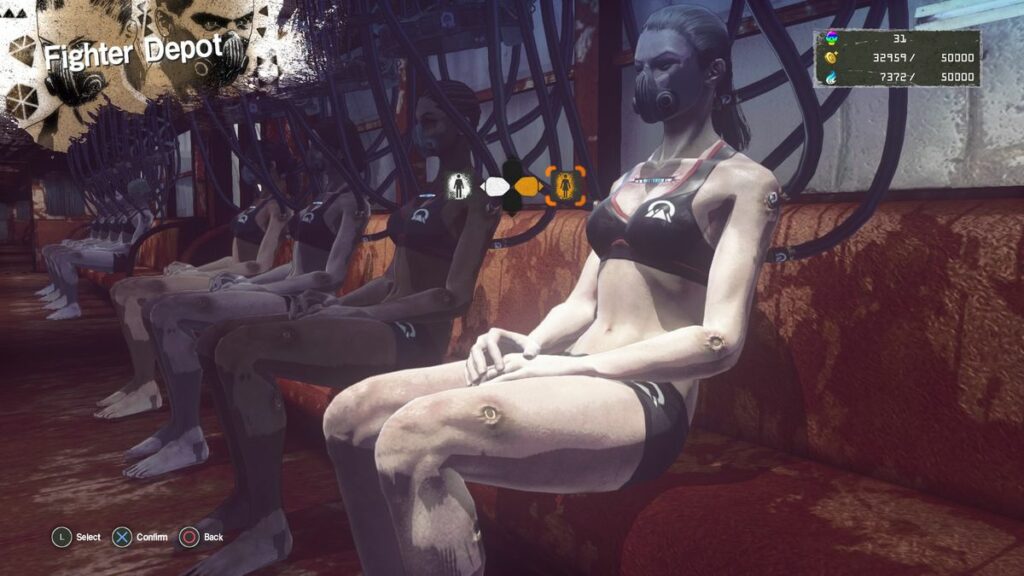
When a fighter dies, his corpse will be reanimated as a Hater, with the equipment and skills he had on him at the moment of his death. This is the game mechanic that spurred the entire change in direction from Lily Bergamo to Let it Die, as other players around the world can theoretically encounter the player’s hater on the specific floor he died on, although there are limits depending on the player’s current level and other unintelligible factors.

At that point, the player has two choices: he can either use another fighter to kill his own Hater, which will return him to the freezer at the cost of all the items and experience he had collected during its run as well as any non-premium decals, or pay a fee to have him returned safe and sound. It should be noted that neither of those is permadeath, and as we explained before, the game is not procedurally generated, but rather a randomized selection of pre-set rooms, meaning that Let it Die defines itself as a Rogue-like entirely through the adoption of ancillary characteristics to the genre that were implemented 25 to 30 years after its inception.
Each floor will only ever spawn one Hater. As such, the player will mostly be fighting Tubers and Screamers. Screamers are simply reanimated corpses, much like the ones used by the player, controlled by the local Don, while Tubers are cybernetic abominations built by Yotsuyama Bionics out of corpses and spare parts as weapons of war.
Far more dangerous are the three mini-bosses, CO-EN, JIN-DIE and GOTO-9, built again out of corpses and spare parts by Hiromitsu Terada, CEO of Yotsuyama Bionics also in charge of the Tubers project, which then joined in a three-way civil union and gave birth to a fourth mini-boss, U-10.




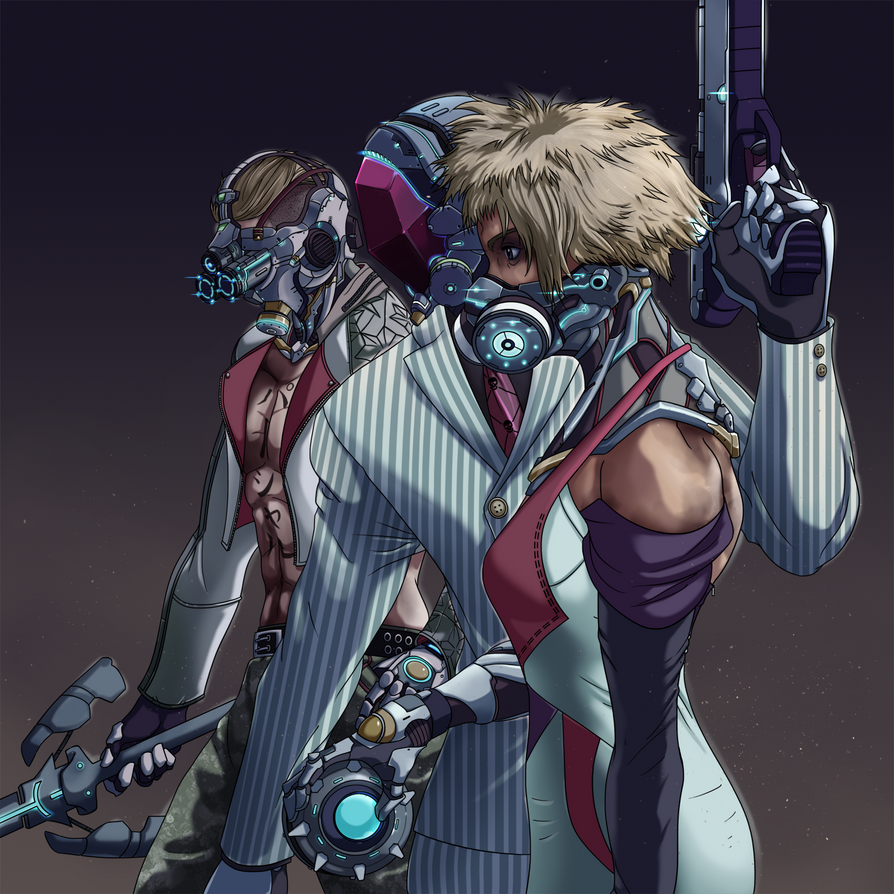
If players spend too much time on a single floor, with the timer being accelerated by killing every enemy, they will be hunted down by the Jackals, body collectors dispatched by Sunflower Ceremony. These enemies far outrank any normal player, and yet, if they manage to build a strong enough fighter, they too can be farmed for their exclusive blueprints.
Outside of climbing the tower, the player also has access to the aforementioned Tokyo Death Metro, the game’s PVP system in which players can raid each other’s bases. It is up to each player to set up a reliable defense system by assigning unused fighters to defense roles and by upgrading their home base. Fights are not played out in real time, meaning that all online interactions are purely indirect: outside of being able to send out hunters, which are functionally identical to haters except for the fact that the player has to initiate their expedition manually, this is the full extent of the game’s online functionalities. Direct interactions are completely impossible: one will never face another player directly, nor are they allowed to cooperate.
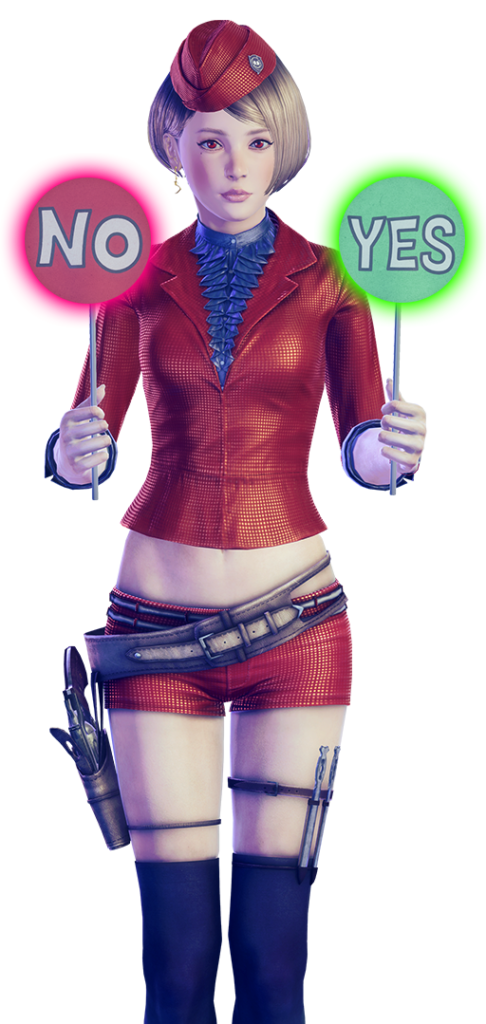
In other words the game is mostly a single player experience, with only minimal server interaction.
Let it Die was developed, since its inception, as a freemium game, meaning it could be downloaded for free on PlayStation 4 consoles. Its monetization scheme came in two different formats:
The first one is through a currency that can be exchanged for real-life money, called Death Metals. While a few of these can be earned for free within the game, it is an utterly inconsequential number compared to what could actually prove useful.
Death Metals have several functions: the most prominent one is being able to revive a fighter instantly after death, a system handled by insurance agent Kiwako Seto. They can also be exchanged for in-game money, Kill Coins, at a rate which is utterly inconsequential and offensive for anybody who has the most basic understanding of the economy, or spent to speed up development or purchase timers.
Most notably, Death Metals can also be used to expand the player’s storage space, which becomes mandatory in anything but name as materials and other useful items will pile up extremely quickly through the course of a normal playthrough.
They can also be spent in the game’s gacha system, operated by the Mushroom Magistrate, which rewards the player with premium decals: while this system can be operated even with in-game Kill Coins, the decals purchased with Death Metals are picked from a smaller pool of more effective ones, and is sometimes subject to special events where the pool is restricted even further.
Later updates also introduced the Hernia machine, which, among its various functions, also allows players to spend Death Metals on a rotating pool of rare materials or blueprints.
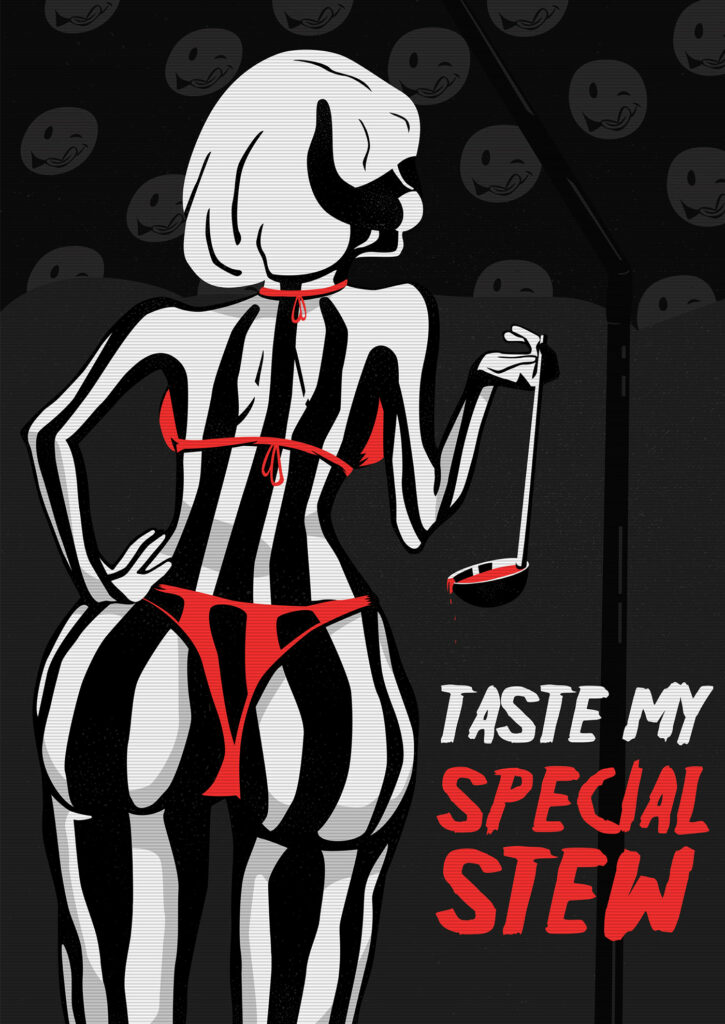
The second monetization system comes in the form of a monthly Direct Hell Express Pass. Much like the Death Metals, players do have access to a free alternative in the form of daily passes which can be earned as in-game rewards, while the one available on the online store covers a full month.
Purchasing the monthly subscription will insure players against TDM raids, meaning that any losses in terms of Kill Coins of SPLithium (the second in-game currency used to develop new equipment and to upgrade the base) will be refunded in case of a defense failure. It also increases the equipment load of every single fighter by ten slots, substantially reduces the cost of returning a dead fighter to the freezer and grants an additional daily log in bonus, which is delivered by Captain Yotsuyama, the company’s mascot who does not appear in the actual game beyond delivering some tutorials and bonuses.
The Express Pass also grants access to the Royal Elevator operated by Rin Torai which, as opposed to the regular elevator, is free and allows for human companionship. Interestingly, using the Royal Elevator enough times will lead her to open up to the player, sitting down on the couch with them during rides and sharing some interesting private details.
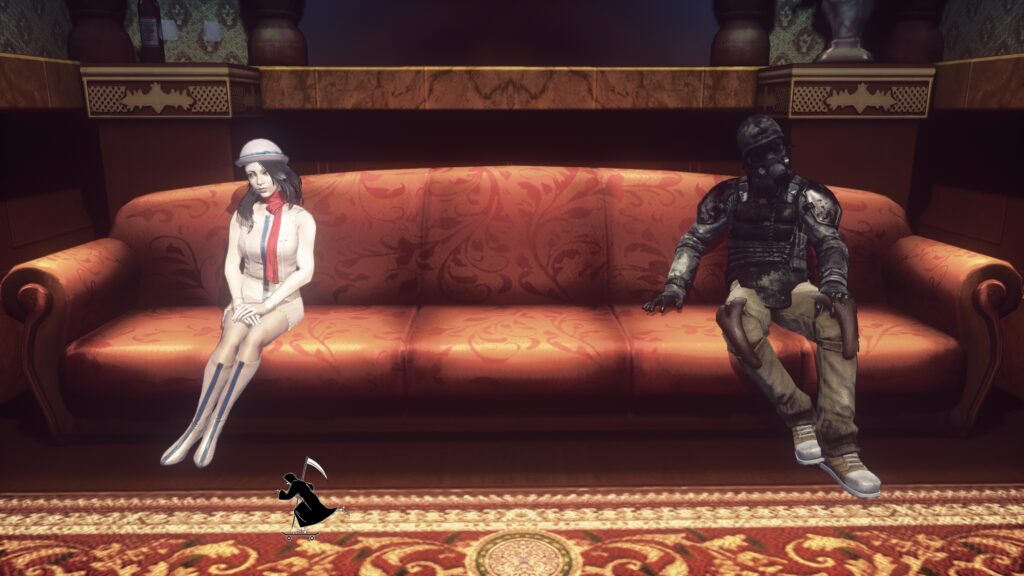
For example, she will mention being the sole survivor of the Earth Rage earthquake, which might imply the player and everybody else around him are wandering souls possessing dead bodies (a detail which possibly ties into the ending), or it could simply be a statement restricted to her actual location (as in, she’s the only one who survived the Earth Rage in the south-western Tokyo area).
She also mentions being stuck inside the elevator for at least 20 years, which helps frame the game chronologically when compared to the intro. As the elevator appears to be the only safe space in the whole tower, Rin is the only character who does not wear some kind of respirator device.
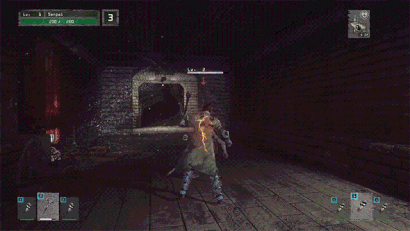
The original statement by the staff of building the game to avoid a pay-to-win scenario is mostly true, albeit a bit disingenuous. While it is true that technically all players can reach the ending without spending any money, having minimal storage space is such a hindrance that it would add several dozens if not hundreds of hours to the average playthrough, and retrieval and elevator costs are so high in the final stretch of the tower that the choice between purchasing a monthly pass or spending dozens of hours to grind the extra money necessary to operate these facilities seems an obvious one.
In the interest of fairness, however, it should be noted that thanks to constant discounts, the price of these microtransactions is more than fair, especially when compared to its predatory competitors, and an average player can realistically complete the game at a leisurely pace investing less money than it would cost to pay for a single-player game of similar length.
While paying customers do have an advantage in terms of having a more comfortable experience, Let it Die still involves an amount of gametoil unprecedented in the company’s history. While some dubious design decisions led to certain scenarios in games like Samurai Champloo, One Night Kiss or No More Heroes 2 having absurd amounts of enemy waves, LiD is the first one to implement a randomized drops for materials.
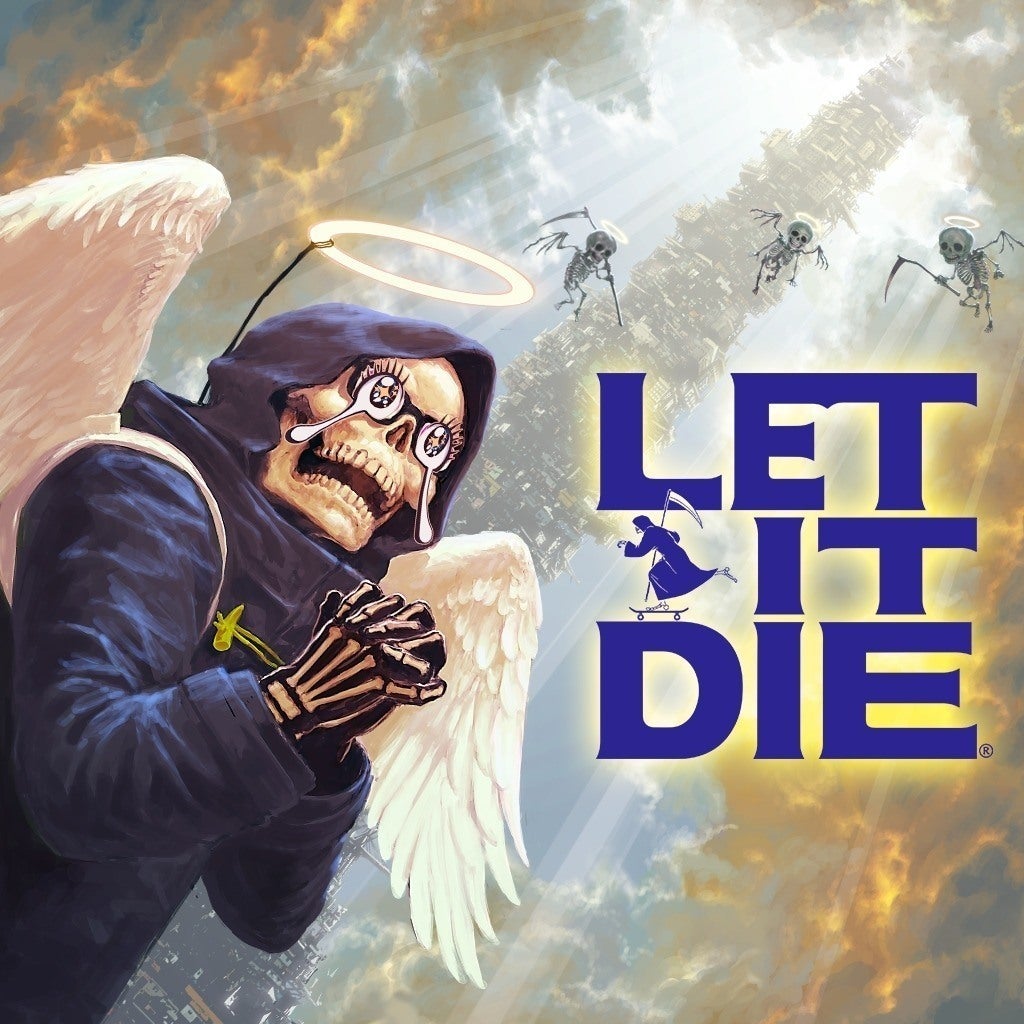
As I explained earlier, no amount of skill will ever make up for inadequate equipment in Let it Die, meaning that, regardless of the player’s policy in terms of investing real money into the game, they will eventually be forced to grind in order to progress, and the gametoil becomes especially grating when it comes to mini-boss-exclusive materials, as mini-bosses are often located in out-of-the-way floors and a single run for the chance to possibly get one material you need out of twelve can take up to 30 minutes.
Players who manage to endure the grueling grind required to defeat the four Dons and conquer the tower are rewarded with an extremely abrupt ending in which it’s revealed that Uncle Death is not just literally Death, but also the president of the Yotsuyama Group, which, while not directly responsible for the Earth Rage earthquake and the creation of the Tower of Barbs, assumed control of it to use it as training grounds to strengthen the souls of the dead, which are amassing on the moon which is secretly a ball of fire made up of said damned souls and is about to collide with planet Earth, destroying it. In a twist of fate, Uncle Death is so impressed by your gaming skills that he impromptu decides to spare Earth so you can play the Death Drive XXX together, so he kills the final boss for the player and the two of them return to the Arcade.
Yes, that is the actual ending. Depending on your playstyle and willingness to invest money, it can take up to 150 hours of gametoil to reach it. I can’t help but think that a fifth area must have been conceptualized at some point, possibly with a final confrontation with Uncle Death himself or even Captain Yotsuyama, but with most of the game’s development history existing under wraps, this is only a guess on my part.
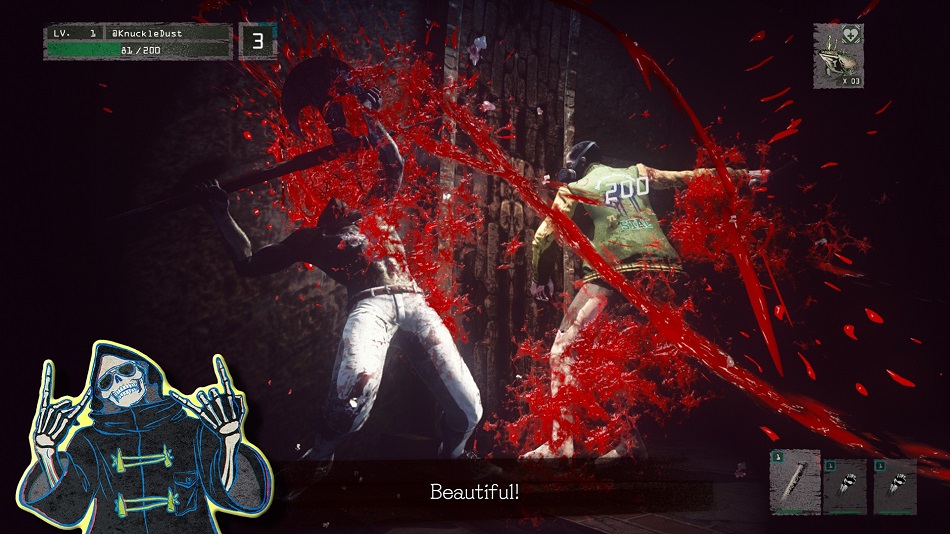
It should be noted that, despite appearences, Let it Die was likely a cheap game to produce: each area only has a handful of rooms in which item locations, while randomized, never actually change, and enemy spawns are fixed. Most enemies operate under the exact same logic as the player characters, in fact even using the same models, and the four “proper” bosses are just re-skins of the four mini-bosses with some additional attacks and gimmicks. Having reached 8 million downloads by 2024, it is easy to infer that even if a small percentage of players decided to invest money into the game, it most likely became profitable shortly after release.
Despite its huge success, Let it Die is also the most risquée game released by the company since killer7. While it does not technically feature manslaughter, as all the players and enemies are living dead, the amount of gore in the game is absolutely unprecedented for the company, with impalements, dismemberments and decapitations being downright mundane by the end, not to mention a psychopathic level of animal abuse where players can hold a defenseless, living rat (or other beasts) to a fire as it desperately tries to free itself only to recover some health by eating it.
This isn’t to say that Let it Die is a grim game; its over-the-top violence is mostly played for slapstick humor, but I want to remind readers that the last Grasshopper game to feature any real bloodshed had been No More Heroes 2 in 2010, with even Killer is Dead, a game based around an execution agency, featuring inhuman monsters as enemies. It is also worth noting that, while the obligatory blonde Kiwako Seto sports some zettai ryouiki and the Mushroom Magistrate is a slut, the game barely features any lewd content, and neither character was played up in advertisement, again marking a big change from the rest of Grasshopper’s Blondes Era output.
After main development wrapped in 2016, a radical shift began to take place in the company, similar to the Planet G split of a few years prior: SUDA51, inspired by the rise of indie gaming, decided to downsize his company to focus on smaller projects.
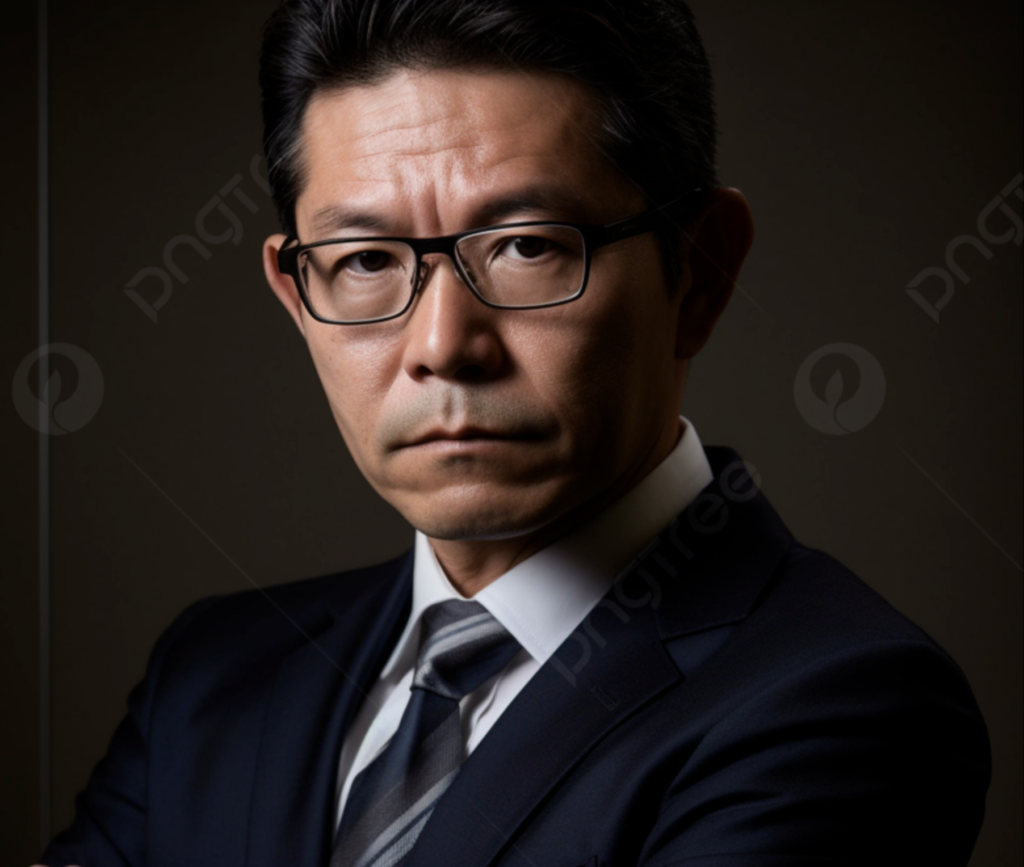
We know that changes were underway at least as far back as mid-2017, when the first game of this new Grasshopper, Travis Strikes Again, was announced. On April 11th 2018, Goichi Suda founded a new company simply called GhM. Then, on June 1st 2018, Grasshopper Manufacture, the previous company and subsidiary of GungHo, changed its name Super Trick Games Inc. On that same date, the new GhM changed its name to Grasshopper Manufacture.
Why these corporate changes always involve bizarre name swaps is beyond me, and knowing this information only serves to evoke in me the idea of a cold and calculating Japanese accountant who wears Gucci suits and square glasses and is also the villain in a police drama dealing with stock market manipulation, where he is ultimately arrested by a down on his luck police detective whose wife (who is a terrible cook) hates him for working too hard and never spending time with their son, who may or may not get kidnapped in the season finale. In season 2 he gets saddled with a rookie partner who nonetheless helps rekindle his love of justice and…

The Newborn GhM only had a roster of twenty people, meaning most of their employees remained in Super Trick Games, most notably, Hideyuki Shin, Akira Yamaoka and Kazuhisa Watanabe, the last remaining member of the original 1998 Grasshopper band. Others, like Tadayuki Nomaru, kept working with both companies, meaning the split was likely amicable.
As it is common for live service games, Hideyuki Shin and Super Trick Games would release several updates and expansions for Let it Die through the years, and the game also took part in several crossovers.
March 30th 2017 – Collaboration with Lily Bergamo. The collaboration is actually a joke, unlocking a single Decal which does nothing.
April 26th 2017 – White Steel, the first of the Four Forcemen, is added to the game. The Four Forcemen are new optional bosses with their own sets of armors and weapons to be farmed.
The Yotsuyama Chargers, stronger Haters which drop dedicated equipment, are also added to the game and randomly spawn through the tower. One of them, the Happy Wheeler, was designed by Masahiro Ito of Silent Hill fame due to the personal connection he and Hideyuki Shin formed while working on Silent Hill 4.
June 28th 2017 – Battle to the Top expansion. Ten more floors with different rules are added to the tower, bringing the total to 51. As the Yotsuyama storyline ends on floor 41, all subsequent floors only feature Haters and are completely randomized, picking rooms from each of the four faction areas. Battle to the Top (and all other expansions for that matter) doesn’t feature any new storylines.
July 10th 2017 – Collaboration with My First Story.
July 28th 2017 – Red Napalm, the second of the Four Forcemen, is added to the game.
August 9th 2017 – Collaboration with Gravity Rush 2.
October 24th 2017 – Black Thunder, the third of the Four Forcemen, is added to the game.
November 30th 2017 – Collaboration with World of Tanks.
January 29th 2018 – Pale Wind, the fourth of the Four Forcemen, is added to the game.
April 26th 2018 – Collaboration with Killer7.
July 2nd 2018 – Tengoku expansion. Tengoku is a series of randomized floors, again populated only by Haters, where players can grind for exclusive weapons and equipment. Originally, the highest floor one could reach was 201, but later updates raised the cap to 251, 301 and finally 351. As always, Tengoku doesn’t include any new cutscenes or story content, but reaching each milestone rewards the player with a different letter from Uncle Death.
August 26th 2018 – Let it Die is released on Personal Computers.
November 14th 2018 – Collaboration with No More Heroes. It is notable that this was done specifically to advertise the upcoming release of Travis Strikes Again, another hint that the GungHo/GhM split has been amicable.
February 24th 2021 – Collaboration with Ninjala.
May 18th 2022 – Collaboration with DeathVerse: Let it Die. More on that later.
November 26th 2023 – Neo D.O.D. expansion. A new variation of Tengoku floors culminating in a fight with a higher-difficulty version of White Steel. Armor skins are also added to the game.
May 29th 2024 – Neo W.E. expansion. A new variation of Tengoku floors culminating in a fight with a higher-difficulty version of Red Napalm.

At the time of writing (July 2024), Let it Die is still alive and kicking, although, unfortunately, it seems that each update keeps moving it away from its cohesive scrapyard aesthetic and more towards the neon colors of hopepunk. More importantly, its nature as a live service game means it is only a matter of time before it disappears.
October 2021 saw the surprise announcement of a Let it Die spin-off, titled DeathVerse, again directed by Shin. Picking up the plot threads of the Yotsuyama Group and their connection with the world of the dead, DeathVerse takes place centuries after the original Let it Die in a virtual world, the titular DeathVerse, where the souls of the damned fight to the (second?) death in a reality TV show, Death Jamboree, hosted by the Yotsuyama Broadcasting Company. Winners are awarded a cash prize which they cannot spend because they are dead.
The game mostly starred a new cast, with morbidly obese host Bryan Zemeckis and the cheerful sexy cripple QueenB taking center stage and a new puppet called Admiral Honda. Uncle Death was shown watching the reality show in the opening cutscene, and his absence was noted in developer updates and the like, meaning his introduction in DeathVerse was likely planned to be a big event at some point.

Funnily enough, QueenB was also turned into a V-Tuber to advertise the game. In case you’re reading this from Mars, V-Tubing is a disgraceful and humiliating social phenomenon that goes against any law of God and Man where a “person” puppeteers a cartoon character in a grotesque mimicry of human interaction for the entertainment of billions.
Unlike the original Let it Die, DeathVerse was a multiplayer battle royale game, and the player would create his own avatar which would then serve as the main character of the game. After a short open beta in May and June of 2022, the game was released on PlayStation 4 and 5 consoles and on Personal Computers in between the end of September and the beginning of October of 2022, and its shut down was announced after only three months because NOBODY played it.

From what footage of it survives, which I am not going to link to to spare you the grief of having to listen to the grating voices of “professional streamers” or, even worse, having to look at their horrid visage as they pretend to speak with cartoons, it seems that players almost always ended up having to fight bots due to the lack of actual human interest, and according to Steam Charts, the game’s player base peaked at 1380.
Being one of the 8.005.174.620 people who never played DeathVerse, I cannot comment on its gameplay, but footage of it seems to indicate that the control scheme wouldn’t have been much different from that of its predecessor, likely an unhappy choice for the more precise and fast paced action required of a battle royale game.
As all dead things do, the game managed to find its way to Paradise Hotel. I managed to extract its soundtrack, movie files, sound effects and voice overs, but I was unable to decipher the bigger of the two archives which might contain textures, character models and so on due to my inexperience with Unreal Engine.

Just as service was suspended indefinitely in July 2023, Hideyuki Shin and Uncle Death himself announced that they would begin development on what is essentially a brand-new title, built in Unreal Engine 5, which would combine the single-player hack-and-slash nature of the original Let it Die with the PvP elements of DeathVerse.
After this announcement, new areas were also added to the original Let it Die, likely to try and rekindle some interest in this potential third game.
This untitled “Let it Die 3” seems to be the only game currently in development at Super Trick Games; while we all sit in silence, waiting with bated breath, we can delight ourselves in watching Hideyuki Shin and Uncle Death take part in goofy challenges on their official YouTube channel.

